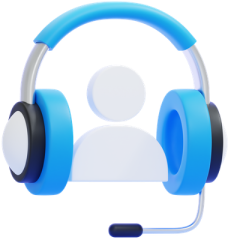18 Nov 2024
How to Develop an App Like Doximity: A Comprehensive Guide
Matthew Connor
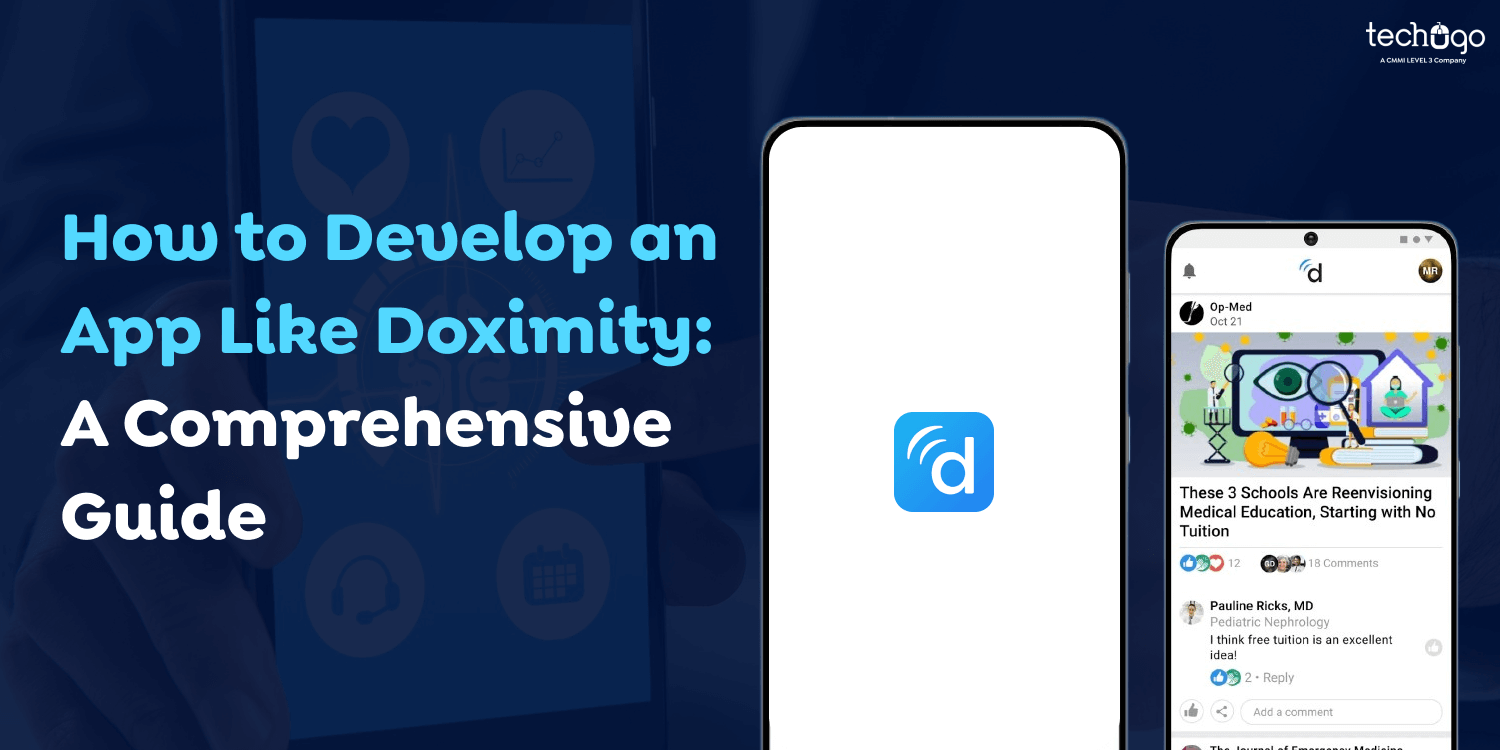
The growing need for healthcare professionals to work together and effectively communicate has prompted a great deal of work in developing specific platforms for the healthcare business. Doximity is a prime example of an app that has changed how doctors communicate and work together.
Doximity is a groundbreaking app that has transformed how healthcare professionals interact, collaborate, share information, and gain access to employment opportunities. The key to its popularity lies in its capacity to cater to doctors’ particular demands and foster collaboration and unimpeded communication within the health industry.
Making a medical-oriented app comparable to Doximity is a multidisciplinary process combining technology innovation and a deep understanding of special requirements and restrictions within the health industry. A platform like this is vital in enhancing healthcare efficiency as it permits secure communications between doctors and the ability to access medical literature and educational resources. If you’re looking to develop apps like Doximity, one of the most crucial aspects is the development expense.
In this blog, we’ll discuss the cost of developing the Doximity app and the factors influencing its cost.
So, let’s get started.
What Is The Doximity App?
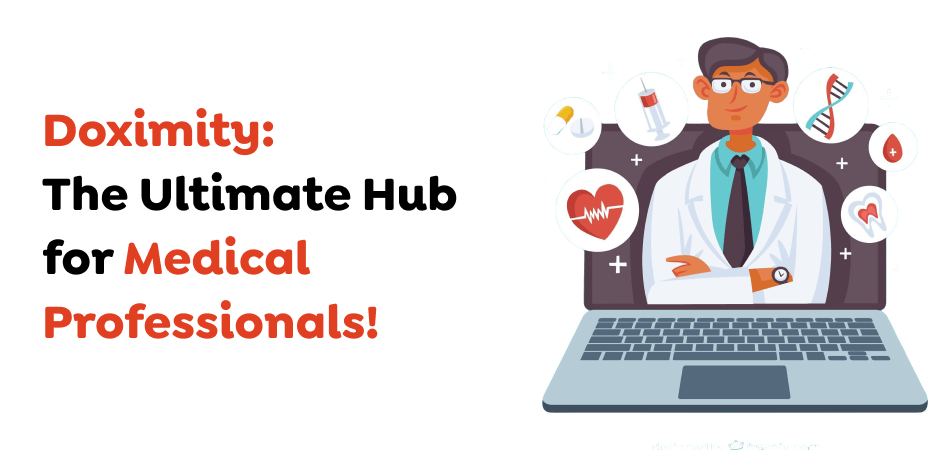
Doximity was among the first and perhaps the most influential attempts to create an online medical network. They claim to be the largest network of medical professionals. The site has been referred to as the doctor’s social network as it is a LinkedIn physician’s network, a news and medical information delivery service, a rank list, and a messenger application. Certain tech-savvy people even use Doximity to look up a doctor’s profile to verify its legitimacy. Doximity is all it, plus more.
The Doximity application is the company’s plan to make its platform available to mobile devices. This device will clarify that Doximity is, first and foremost, a social platform and a service with instruments to help simplify your life.
It’s a simple method to share information, communicate with colleagues who are far away, and communicate with your patients. The addition of the earlier distinct Doximity Dialer application to the core Doximity app sets it to be considered one of the essential applications all modern doctors should carry on their smartphones.
Also Read : Transforming Healthcare: How to Build an App Like GoodRx
Must-Have Features Of Apps Like Doximity
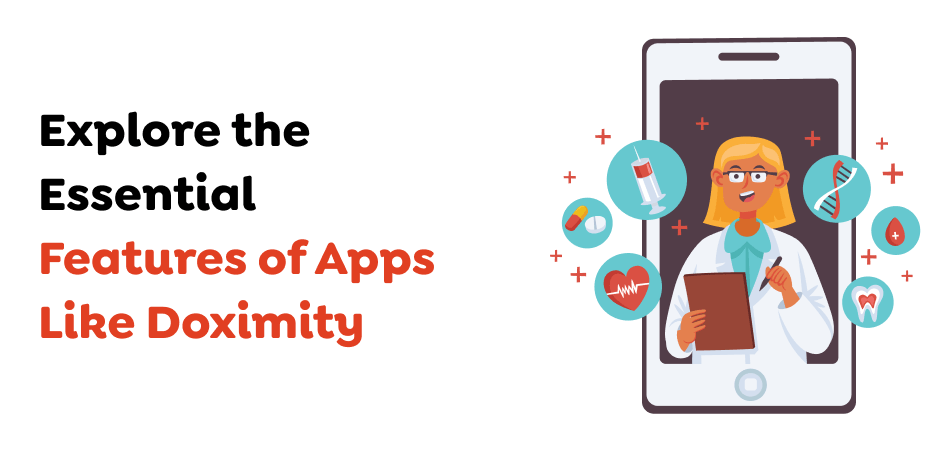
In this section, we will look at the key features of apps like Doximity and it is important to understand that features also play a key role in evaluating the total cost of development.
1. Physician Directory
Apps similar to Doximity should have a complete list of verified healthcare professionals and let users search for experts, colleagues, or medical specialists by various criteria, including specialty, place of work, hospital affiliation, and medical schools attended.
2. Secure Communication
This is among the most beneficial attributes. Through Doximity, doctors can discuss sensitive data or seek an opinion from a different doctor without needing to call or be concerned about breaking HIPAA rules. In the end, you’ll be able to receive an appointment or referral with any physician anytime within Canada.
Communication and messages will be delivered through SSL (secure socket layer), which is encrypted according to military standards. Biometric (fingerprint) login is possible for authentication on mobile devices.
3. Medical News And Updates
Through apps like Doximity, users can access the most current information on medical research, news, and updates on clinical research. This feature informs health professionals of the latest advancements within their field and the latest trends in health care.
4. Professional Networking
This will create a space for healthcare professionals to communicate with colleagues, develop professional networks, and collaborate in clinical or research initiatives. Participants can join specialties-specific group discussions and discussion forums and share their insights with colleagues in their respective fields.
5. Career Opportunities
Career opportunities for healthcare professionals include open physician positions, academic jobs, and opportunities within the industry. You can browse job listings, apply for positions, and connect with prospective employers and recruitment agents.
6. Fax
Healthcare professionals can make and receive faxes securely by using the application’s electronic faxing feature, which can be sent directly through their laptops or mobile devices. This feature simplifies communication and reduces the burden on administrative staff because it eliminates the need for traditional fax machines and paper-based communications.
7. Alumni Networking
The app’s alumni network features assist medical professionals in contacting former students, alums of residency programs, and fellow medical school students or training courses. This feature allows students who have graduated to connect with mentors, connect with them, and further their careers in medicine.
8. Job Listings
Doximity-like apps allow employers to post job openings using a recruitment tool. Job seekers must openly provide information about the position, such as salary, area, and other important information. Doctors can search for job opportunities according to location and specialization. Like Doximity, it includes a function that lets doctors compare their pay with other doctors in the same area.
9. Colleague Collaboration
It allows doctors to communicate and collaborate with specialists in similar fields or areas of expertise. For professional networking and information sharing, patients can join groups tailored to their expertise, engage in discussion, exchange thoughts, and seek advice from colleagues.
Also Read : How Much Will It Cost to Create an AI-Based Shopping App Like Target?
Cost To Develop a Medical Networking App Like Doximity
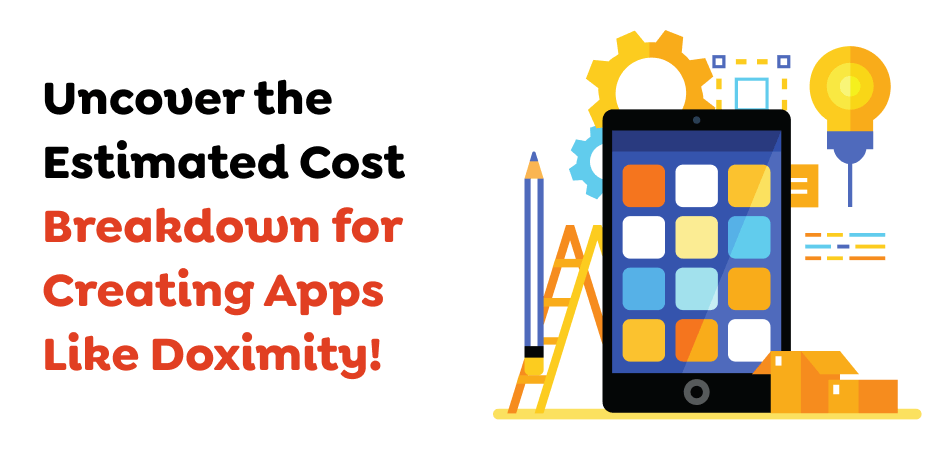
Various aspects contribute to the total price of creating a social media platform tailored explicitly to doctors. The cost to develop an app in Canada like Doximity may range from $40,000 to $300,000 or even more, based on several variables. The complexity of features, design complexity, platform compatibility, and security features are a few aspects that affect the development costs.
Basic App: Starting at $30,000
Mid-Range App: $50,000 – $100,000
Advanced App: $100,000+
Factors Impacting The Cost Of Developing App Like Doximity
Depending on various variables, the costs of developing an app like Doximity can range from $40,000 to $300,000. Factors include the complexity, capabilities, platform compatibility, overall design dimensions, and locations of the team developing it. We’ll review those.
1. Features And Functionality
Development costs are affected by the app’s complexity and number of functions. Building the medical network app, Doximity is expensive, and the cost is likely to increase as you add the budget and time needed to develop features such as encrypted messaging technologies for telemedicine, electronic medical record (EHR) integration appointments, scheduling, and sharing of medical information.
In addition, the difficulties of developing advanced functions like video-based consultations in real-time, AI-driven diagnostic tools, and geolocation-based solutions could add to the cost of development. It is crucial to prioritize options based on users’ needs and budgetary constraints to guarantee that the development process is efficient and cost-effective.
2. Integration Into External Systems
Connecting the app to external applications, like EHRs, lab information systems (LIS), and billing software, takes more development time and can result in integration or licensing fees. Testing and validation ensure seamless data exchange and compatibility between the app and current systems.
This increases the cost of developing an application for medical networking, such as Doximity. Costs for integration in the long term increase because of ongoing maintenance and updates required to adjust to the changes to the external APIs and protocols of systems that ensure continuous functioning and interoperability.
3. Design And User Experience
The application’s user interface design plays a crucial role in keeping customers. Although design and modification resources can be costly, investing in a user-friendly layout and seamless navigation can increase involvement.
Prototyping, user research, and usability tests are vital processes that can increase the cost of design to ensure that the app meets the preferences and needs of the target users. Focusing on user-centered design is crucial for efficiently managing medical network application development costs and ensuring the users a pleasant and enjoyable experience.
4. Security And Compliance
The strictest security and compliance rules, similar to those set out by the Canadian healthcare government bodies must be adhered to by the medical network applications. Implementing robust security measures, including access restrictions, audit trails, and data encryption, is vital to protecting personal patient information and ensuring regulatory authority compliance. Development of an app like Doximity is further complicated by constant compliance surveillance, regular security audits, and employee instruction to keep up with changing regulations.
5. Size Of Development Team
A third factor that influences the price of building an application like Doximity is the number of developers. If a larger team with a project manager, QA engineers, developers, and even designers could complete the project more efficiently, the price of labor is likely to increase. However, you can still get a top-quality end product after launch support and maintenance.
Engaging an experienced and knowledgeable team to develop apps could speed up development thanks to their experience and knowledge. Professional developers are skilled in managing complex workflows, streamlining processes, and making educated choices. This results in a quicker understanding of the most effective methods and problem-solving techniques that help them rapidly overcome obstacles and ensure the speedy application of top-quality solutions.
6. Platform Compatibility
The cost of mobile app development depends on the platform selected, which is iOS, Android, or both. Development for multiple platforms can increase expenses due to the additional cost and time required. The costs for development are further enhanced by the ability to tailor the functions and appearance of the application to each platform to ensure an excellent user experience. It is essential to be taken into consideration at the time of planning for cost control.
7. Development Team Location
The location of healthcare app development company impacts the price of creating applications similar to Doximity, specifically for health professionals. In the wake of the growing trend of offshoring, outsourcing companies in countries such as Canada and Asia will provide you with their wide knowledge, expertise, and the latest technologies that can transform your ideas into successful ventures while ensuring compliance with international and local rules.
Also Read : How Much Does It Cost to Develop an App in 2025? A Comprehensive Guide
Revenue Models Of Apps Like Doximity
By diversifying the revenue stream and providing services that add value to patients, a medical network app such as Doximity will establish a long-lasting business model that encourages collaboration and innovation in the health sector.
1. Recruitment Services
Offer assistance in recruitment to health facilities and healthcare institutions seeking to fill vacant positions with qualified applicants. It could be in the form of job ads, databases, or recruiting campaigns. The business model can make sense for employers to charge a fee to post job openings or use the application’s recruitment features.
2. Subscription Model
Healthcare providers can choose from different subscription plans based on tiers in the subscription model. Although premium services like enhanced capabilities for telehealth, improved analysis, and access to expert information might require a subscription, the essential features could be provided for free.
3. Partnerships And Sponsorships
Establish strategic partnerships and sponsor agreements with medical associations, educational institutions, healthcare institutions, and the business community. The collaborations could be co-branded and sponsored content and joint marketing campaigns that generate income through sponsorship payment.
4. Data Licensing
De-identify and collect user data to provide insights and data for pharmaceutical companies, healthcare research institutes, and various other parties. Data access can be licensed to generate a significant gain while ensuring user anonymity and confidentiality.
5. Courses For Continuing Medical Education
Work with approved CME companies to provide CME courses, webinars, and online courses via the application. Health professionals can provide paid access to educational materials, helping users fulfill their ongoing education requirements.
6. Telehealth Services
Integrate telehealth into the application, allowing users to pay for virtual consultations with medical experts. Include paid services such as online prescriptions, secure messages, video consultations, and appointment booking to improve user satisfaction and earn revenue.
7. In-App Purchases
Users can improve their experience through in-app purchases by purchasing additional features, premium content, or virtual goods. These can include online forums, virtual meetings, and research resources.
8. Advertisement
Offer opportunities for pharmaceutical firms, medical equipment makers, healthcare establishments, and other related entities to promote their services or products for healthcare professionals via the application. Advertisements can target customers based on their interests, specializations, or geographic location.
Also Read : Unlock the Future of Finance: How to Develop a Neobanking App Like SoFi
Steps To Build An App Like Doximity
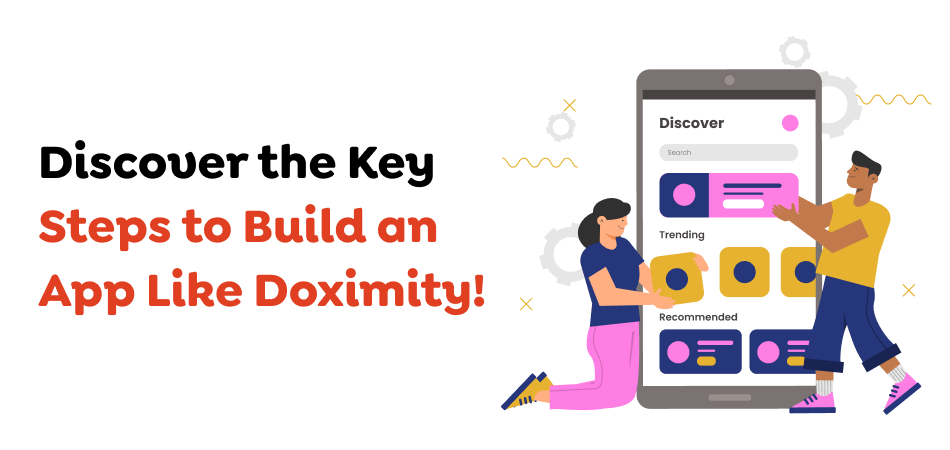
The development procedure follows several essential actions. By following these steps and leveraging the experience of skilled developers, you can create effective medical network apps like Doximity. App that perfectly meets the requirements of medical professionals and improves cooperation and patient care.
1. Conduct In-Depth Market Research
Study the market extensively for a better understanding of the needs of healthcare professionals as well as their preferences and issues. Find out the gaps in the market and potential and evaluate potential competitors in the field of medical networks before diving into the process of development
2. Define Your Unique Value Proposition
Find the distinctive qualities and features that distinguish your app for medical networking apart from the competition. Think about how you can enhance collaboration, interaction and patient care, while also meeting the needs of healthcare professionals with their unique needs.
3. Plan Your App Architecture
Define the structure and style of your app for medical networking, including the design of the user interface (UI), user Experience (UX), backend infrastructure, and data structure. Select the frameworks, technologies, and tools you’ll employ to develop and maintain the app.
4. Prioritize Core Features
Create secure essential application features for medical networks, like chat and telemedicine, appointment scheduler integration with EHRs, and the medical directory. Make sure you provide a seamless user experience and ensure HIPAA security when handling patients’ private information.
5. Incorporate Advanced Features
In order to increase the worth of the software for medical networking include features such as electronic faxing, newsfeeds, colleague and alumni networking and powerful search functions. Take a look at how these capabilities could improve the networking of healthcare professionals, as well as their communication and collaboration.
6. Develop Your Application
Create your app’s frontend and backend design, paying close consideration to usability, efficiency, and utility. Make sure that the frontend and backend components work seamlessly throughout development to ensure users have a consistent experience. Implement agile development strategies for continuous improvement and flexible response to changes in requirements.
7. Assure Security And Compliance
Put in place strict security measures to guard patients’ data and make sure that you are in the compliance of HIPAA as well as other health regulations. These measures include access controls that require multi-factor authentication and encryption of information in the process of transport and in storage regularly conducting security audits that identify and correct vulnerabilities.
8. Conduct Thorough Testing
Perform extensive testing and Quality assurance (QA) to ensure that your app for medical networking fulfills medical professionals’ requirements and functions as designed. Test for security, performance, accessibility, usability, and compatibility with a variety of gadgets and platforms.
9. Deploy And Launch
Prepare for the release of your medical network app by developing a marketing strategy that will generate interest from medical professionals and improving the listings on your App Store. Launch the app on Google Play and App Store. Then, monitor the user’s interaction and comments to implement iterative adjustments.
10. Ensure Continuous Support And Maintenance
Give your medical network app with ongoing support and maintenance for responding to feedback from users to address issues and bugs as well as roll out updates and new features. Examine your app’s functions, safety, performance, and security thoroughly to ensure its long-term stability as well as a pleasant user experience.
Also Read : How to Build an App Like Waze: Key Features and Development Process
How Apps Like Doximity Impact The Canadian Healthcare System?
There are numerous significant distinctions between the USA and Canadian healthcare systems. However, we also find some unique and exciting similarities in the USA and Canadian healthcare systems regarding healthcare professionals, their needs, areas of pain, and solutions.
This gives us faith in a social network program for doctors such as Doximity, which is proving extremely successful in Canada. Here are some of the most effective ways that an app such as Doximity can affect the Canadian health system.
1. Telemedicine Is Accessible To Health Professionals
Currently, healthcare providers in Canada are either building their own online telemedicine system or acquiring a third-party ready-to-use telemedicine system to provide online medical consultations for their patients. That is, there is no alternative but to invest huge sums in a telemedicine platform.
However, by creating an application similar to Doximity, it is possible to allow medical professionals to provide virtual consultations as part of their clinical services and without any cost. The telemedicine program offered by Doximity is available to all doctors, provided it’s an individual visit lasting up to 40 minutes.
2. Clinicians Will Have Greater Clinical Expertise
Apps like Doximity allows users to communicate with experienced doctors, read their writings, and learn some information that is not in the syllabus during their spare time. Additionally, they can create a professional network and seek advice or share their ideas by connecting with other members. There are many indirect and direct ways a Doximity-like app can add value to a medical student’s transition from medical school to a medical practice.
3. Ability To Use a Mobile-Based Unified Communication Platform
In Canadian healthcare, communications and collaboration using mobile applications have not been embraced massively because of technological and regulatory issues. However, by creating a healthcare social media platform such as Doximity, every clinician in large health institutions can connect and collaborate anytime, anywhere, with their smartphones. This leads to more well-informed decision-making since the entire healthcare coordination team is linked to the same platform, which can be easily accessible via mobile devices.
Also Read : Unlocking Efficiency: The Impact Of Apps Like Transit On Public Transportation
Conclusion
While creating medical-related networking apps like Doximity may be daunting, there are many benefits medical professionals and healthcare institutions can gain from it. The app could increase cooperation and the exchange of information among communities by offering secure communications, network information, updates and news, and other vital details.
If you are assessing the expense of developing, it’s essential to look at several elements, such as the feature set, the platform, the design of backend testing, and other features. With careful planning and execution of development processes, companies can create a device that meets the demands of health professionals and improves healthcare for patients. For expert assistance in creating such apps, partnering with Techugo, an app development company, can ensure your project’s success.
Get in touch with us today to start building your app like Doximity and revolutionize healthcare communication!
Get In touch
We are excited to here from you and let’s start something special Together. Call Us for any inquiry.
Write us
sales@techugo.caJust a call away
About you
